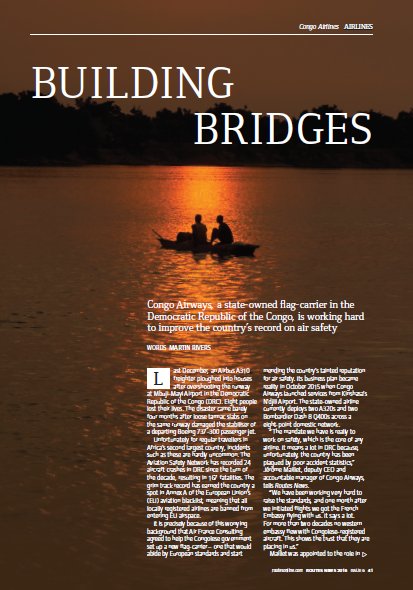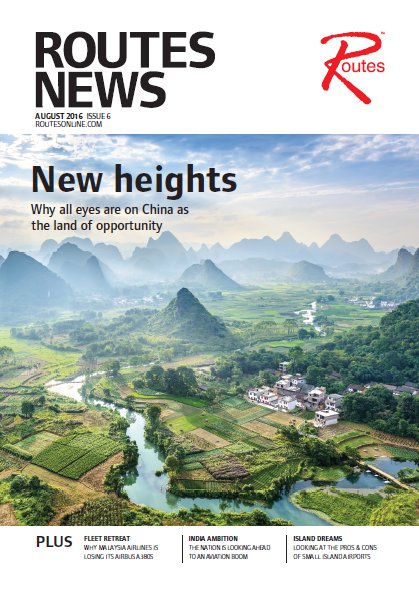Last December, an Airbus A310 freighter ploughed into houses after overshooting the runway at Mbuji-Mayi Airport in the Democratic Republic of the Congo (DRC). Eight people lost their lives. The disaster came barely four months after loose tarmac slabs on the same runway damaged the stabiliser of a departing Boeing 737-300 passenger jet.
Unfortunately for regular travellers in Africa’s second largest country, incidents such as these are hardly uncommon. The Aviation Safety Network has recorded 24 aircraft crashes in DRC since the turn of the decade, resulting in 167 fatalities. The grim track record has earned the country a spot in Annex A of the European Union’s (EU) aviation blacklist, meaning that all locally registered airlines are banned from entering EU airspace.
It is precisely because of this worrying background that Air France Consulting agreed to help the Congolese government set up a new flag-carrier – one that would abide by European standards and start mending the country’s tainted reputation for air safety. Its business plan became reality in October 2015 when Congo Airways launched services from Kinshasa’s N’djili Airport. The state-owned airline currently deploys two A320s and two Bombardier Dash 8 Q400s across a eight-point domestic network.
“The mandate we have is really to work on safety, which is the core of any airline. It means a lot in DRC because, unfortunately, the country has been plagued by poor accident statistics,” Jérôme Maillet, deputy CEO and accountable manager of Congo Airways, tells Routes News.
“We have been working very hard to raise the standards, and one month after we initiated flights we got the French Embassy flying with us. It says a lot. For more than two decades no western embassy flew with Congolese-registered aircraft. This shows the trust that they are placing in us.”
Maillet was appointed to the role in March 2015 after working as a freelancer with Air France Consulting during the development of the business plan. He reports to CEO Désiré Balazire.
As well as continuing to lean heavily on French expertise – the start-up collaborates with Air France Industries on maintenance and training – Maillet has amassed a team of internationally recognised experts to attain the highest safety standards. Two of his operational managers joined the company from Air Côte d’Ivoire, another African flag-carrier set up with help from Air France, while his flight safety officer previously held the same role at Alitalia.
“We have brilliant people, from Congo and also outside of Congo. Operationally we are very, very strong,” Maillet emphasises. “But we are also very humble. We know we can have an incident or accident, so we just deploy a lot of effort to meet the right standards.”
The flag-carrier’s uncompromising approach to safety sometimes comes at a cost. It suspended A320 flights to Mbuji-Mayi Airport just days before the fatal freighter crash, citing in-house inspections that revealed damage to the runway. Other local operators – notably FlyCAA, DRC’s largest private carrier – maintained narrowbody flights to the city after the Civil Aviation Authority failed to take action.
“Our competitor continues to fly there [with A320-family jets],” Maillet says. “What we care [about] is we did our analysis and we decided it was not as per our standards. We lost money not flying, of course.... but it’s not just words when we say we place safety as our core value, truly as number one.”
Congo Airways subsequently resumed flights to Mbuji-Mayi with smaller and lighter Q400s, which can land more easily on the runway. But it is withholding launches to other lucrative stations, notably the northern city of Gemena, which Maillet accuses of lacking the necessary emergency fire-fighting equipment.
“Others are flying [to Gemena]. They are very happy, fully booked, people even fighting at the airport to get a seat,” he says. “The fares are totally crazy – twice the yield – and OK, fair enough, good for them. But that is not how we want to play. This [more cautious approach] is the vision of the chief of state, this is the vision of the prime minister, so we feel very comfortable. It serves Congo Airways, it serves the Civil Aviation Authority, it serves the country, and it serves to bring back credibility and respectability.”
Certification under the IATA Operational Safety Audit (IOSA) – the global benchmark for civil aviation safety compliance – should be the next milestone. Maillet expects his team to take the exam by December. If successful, Congo Airways will then approach the EU about being redesignated in Annex B of its blacklist, securing an exemption from the nationwide ban and opening the door to European flights in 2018 (Annex B is the same mechanism that allows TAAG Angola Airlines to serve Portugal, in spite of its home nation’s ban).
“We’re going to ask the EU probably at the end of this year, and hopefully get that by next summer,” Maillet says, outlining details of a “standalone project” to launch widebody flights in winter 2017-18. “We are talking extensively with manufacturers and we’re going to make a decision, probably by this autumn, to see if we can do that within 18 months, or if we’re going to postpone it. If it proceeds, we are going to have two aircraft to start with, a minimum of two routes in Europe from the outset, and a route in the Middle East continuing to Asia.”
Maillet does not specify the European destinations being targeted but says that Dubai and China’s Guangzhou will “very probably” be served. The widebodies will also be deployed to one regional destination. In the event that Brussels declines to grant Congo Airways an exemption, the company is willing to partner with an EU-approved operator for wet-lease services to the continent.
Before any of that is possible, however, DRC’s Civil Aviation Authority must also prove it is up to the task. The regulator’s capabilities have until now been so deficient that it does not even issue Air Operator’s Certificates (AOCs) – one of the most fundamental roles of any air safety oversight body.
“This is very surprising but we fly with no AOC,” Maillet admits. “This is why we fly only domestically. It’s not because we decided to start with the domestic market and then go outside … no, it’s because we cannot go outside the country.”
The International Civil Aviation Organisation (ICAO), the aviation agency of the United Nations, has taken an active role in remedying the situation. Its experts visited Kinshasa in May to coordinate a “safety oversight capacity-building project” for the Civil Aviation Authority, including a full review of the regulator’s structure, organisation and training.
Maillet says ICAO’s involvement in the country should also enable Congo Airways to undergo a one-off certification process predicting: “We’re going to be the first airline to get the Congolese AOC.”
Provided an operating licence is secured swiftly, Congo Airways expects to launch regional services in the fourth quarter of 2016. Its initial routes will be Johannesburg in South Africa, Luanda in Angola and Pointe Noire in Congo-Brazzaville, followed next year by Douala in Cameroon and Libreville in Gabon. The flag-carrier also plans to add four more domestic points in the near future: Bunia, Kalemie, Bukavu and, pending upgrades, Gemena.
Its four-strong short-haul fleet should reach 10 aircraft by the end of the decade, growing at a rate of two units per year. Stretched A321s may be considered, though the airline will otherwise retain its existing types.
Noting that DRC has just ratified the Cape Town Convention, Maillet says aircraft lessors are beginning to feel more comfortable about placing their assets inside the country. That will make it easier for the flag-carrier to secure finance leases, rather than continuing to buy aircraft outright with equity. Talks over the sale of a 20% to 25% stake in the company to a strategic investor - potentially Ethiopian Airlines – also bode well for its financial future.
With territory the size of Western Europe, a vast array of natural resources, an 85 million strong population and an average economic growth rate of 8% per year, DRC has all the ingredients for a thriving civil aviation industry. The poor state of its road and rail infrastructure only boosts the appeal of reliable, safe air transport.
Although the country has long fallen short of its potential in the skies, a willingness to engage with international experts and invest heavily in the future is beginning to pay dividends. “We are at the right moment really to grow this airline, and to turn a page from the past,” Maillet concludes. “We have the strong fundamentals, we know where we want to go, and the idea is just to execute. Our issue, as any start-up, is having perfect execution. And this is what we focus on.”
 |
This article is modified from an original feature that appeared in... ROUTES NEWS - ISSUE 6, 2016 PLEASE CLICK HERE to view the magazine. |
 |
